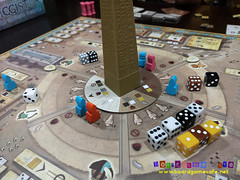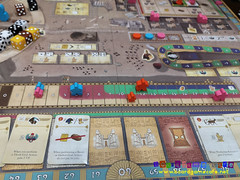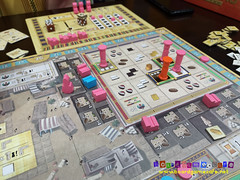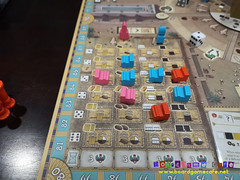Here’s a quick rundown of the other games played at OTK in the past couple of weeks:
Village – Inka & Markus Brand, Eggertspiele

What is it?
Technically not an Essen release (it was released earlier in the year), The Village is the 2012 KSdJ winner. If you are new to boardgaming, the SdJ or Spiel des Jahres is an award given to the best German game, usually given to family friendly games. The Kennerspeil was created to award the “Gamer’s” games.
At it’s heart, Village is a worker-placement game, although putting it into that category draws all kinds of reactions / connotations. There’s actually far more twists to the mechanic, with space activation (more on that later) and you actually want to KILL OFF your workers! Yes, they do actually die. 🙂

The book of death… I mean The Village Chronicle. 😛
The goal, as always is to collect Victory Points, and there’s plenty of ways to do this, from the market to travelling to other villages. Even killing your people appropriately nets you some points (cue evil music).
How does it work?
Players start with 4 villagers (the 1st Generation), a home board with a time track and space for grain storage.

The home board – with time track going around it.
Throughout the course of the game, players take turns, taking coloured cubes from spaces and then activating them. The spaces are:
1. Grain Harvest – produce grain if you have a villager at home, if you have a horse or ox and a plow, your harvesting will be more efficient. Grain is used as currency for other spots.
2. Family – make them babies! Produce a second generation or return a villager to your home tile (this is very important as villagers stay in their location till they die!)
3. Crafts – Produce goods that are used for travelling, market, sales, grain harvest, etc. Some example: ox, wagon, horse, scrolls, etc.
4. Market – Sell your goods for victory points.
5. Travel – A way to collect victory points by sending them to other villages. There are bonuses to be claimed too.
6. Council Chamber – The way to get the 1st player and some other bonuses. Also, every villager still alive here at game end nets VPs.
7. Church – At the end of every turn (when the activation cubes run out), a mass will be held. 4 villagers are randomly drawn from a bag (which includes 4 black NPC villager). Going here lets you have a chance to be picked, and you can guarantee getting picked by contributing to the coffers. This is one of the ways to earn cumulative VPs, as the player having the most villagers in the church nets 2 VPs. There are also additional VPs for surviving members.
Now here’s the interesting part. Each of these spaces usually require time! Whenever your time track makes a full circle, you have to send them to their graves. 🙂 Where they end up depends on where they came from, and since the village chronicle has limited space, you might end up in an unmarked grave (no VPs). When either the village chronicle or the unmarked graves are filled, the game ends.
What do I think about it?
Well, many would argue the merits of this game winning the “Gamer’s” game. It is a middle weight game that doesn’t take long to play and certainly not a brain burner. But we never really know what the criteria is for the KSdJ, so we can argue till the cow comes home (or a villager dies?) 😛
From my plays, this is certainly a good game, with a nice twist to the over-saturated worker placement mechanic, and multiple paths to victory. My worry is that the dominant paths seems to be via the market, if someone is left unchallenged, it’s going to be a stroll in the park. A travelling victory seems hard to pull off and needs a very early commitment (although I tried this and was only 3 points behind the winner). More plays will see if this is true, but for now the game seems tightly balanced.
Seasons – Regis Bonnessee, Libellud

The games does not come with Fleet cards. Heh.
What is it?
Released at Gen Con (and officially to the Europeans at Essen), Seasons has generated quite a buzz. It’s one of the 2 games that were sold out quickly (the other being FFG’s Netrunner) and many have been touting it to be the next 7 Wonders, a crazy breakout hit by an unknown designer!
In Seasons, you are a sorcerer competing with others to be the best. It is a combination of dice chucking, craft drafting and engine / combo building, played over 4 seasons and across 3 years. The winner is the player that has collected the most crystals (aka victory points).
How does it work?
Players start the game by drafting 9 cards they will be using the entire course of the game. The game comes with pre-set decks for beginners, which we played. There is also intermediate (more cards) and advanced (even more cards) levels.
The cards drafted will then divided into 3 piles, each to be introduced at the beginning of the year. This is a very important part of the game, as you will be setting up your end game combos.
The game is ready to begin! The first player will then roll dice matching the season (number of players plus 1).

Those awesome chunky dice!
Each player then picks a die. These dice will determine some of the actions you can take during your turn:
1. Gain energy (currency)
2. Gain crystal (points)
3. Draw card
4. Transmute (changing energy into crystals)
5. Increase summoning gauge (the number of cards you can play in front of you)
You can then take additional actions of playing / summoning a card (by paying it’s energy cost) or activating an ability on your player board (quite powerful, but to be used when desperate as it incurs -crystal penalty at the end of the game).
The leftover die will determine how fast the game moves. Then, the next player picks up the dice, tosses them and a new round begins. The game ends after 3 years.
The game actually revolves around the summoning cards. There are 2 types, items and familiars and they do all sorts of game breaking effects: from giving you more energy, allowing you to summon more cards, attacking other players, etc. The meat of the game is determining how to combo these cards together to maximize your gains and earn crystals.
What do I think about it?
First of all, I have to say the production of the game is somewhat stellar. The dice are huge and chunky and the art is beautiful. As an old Magic:The Gathering player, I love the drafting mechanic and combo building aspect to the game. I can see this as a problem for many, as you have to know what cards work well with others. There’s a fair bit of reading to be done. But once you get over the initial hurdle, you get to see how awesome it is when your combo is in full swing! This game will definitely appeal more to the “gamer” crowd, esp those with a background in CCGs (collectible card games). If you would like to try the game out online, it is available on Boardgamearena.
It is definitely in the running to be my Game of the Year for 2012!
Briefcase – Nikolas S & Sotirios T, Artipia Games

What is it?
This is Artipia Games’ 2nd game and Essen release. Artipia is a small Greek company that is on the rise after on the back of their successful first game, Drum Roll. One thing about Artipia games: their artwork is gorgeous. A drawback though is their games are hard to get as they don’t have a mainstream publisher yet.
Briefcase is deck building (yeah, yeah, like Dominion) and resource management game about the world of business. Players are trying to build their business empires by acquiring companies and activating them. The goal is to gain the most victory points (shocker!).
How does it work?
A pool of companies are set up at the beginning of the game. There are pre-set combinations or you can go random (as I know most of you would like to.. heh).
Each player is given a deck of 12 cards consisting of buy, activation and obstacle cards. This is your decision deck. It starts of pretty crappy with lots of useless (obstacle) cards but as the game progresses you will acquire more buy, activation and hire cards.
During a players turn, he will draw 4 cards from the decision deck:
1. Buy card – allows you to purchase goods or a company.
2. Activate card – allows you to activate a company, thereby gaining it’s victory points, ability and resource.
3. Obstacle card – curse out loud. 😀
4. Hire card – allows you to use other people’s companies.
At any time, you can play 2 similar cards to block a good or company from being bought, This usually follows with more cursing and evil looks. 🙂

Activated companies on a player’s tableau. You can see a company blocked.
As the game progresses, players will try to build an engine / synergy with their companies, to gain better cards for their decision deck, draw more cards, get more goods, etc. to then purchase better companies (those that give high value VPs). There is also an option to activate the central bank, converting your buy cards to VPs, but beware as these cards are removed from the game. Only to be used late game.

The central bank.
The game ends when there are 2 goods left, no more companies to be purchased or no more buy cards left.
What do I think about it?
I’ve only played it twice, first play with totally wrong rules! But the feedback from the table was positive. There is enough going on to set it apart from Dominion. Also, there is less shuffling, as cards purchased don’t go into your deck (companies and goods). Definitely a lot of variation with the number of companies available (30 not including promo expansions!) The game is simple to teach and plays fast (unless you get some AP buggers on your table… not naming names. 😛 ) Looking forward to get more plays of it.
Oh, and the artwork is freaking amazing.
Categories: Meetup, Meetup Cheras







teach me berifkes!!!!
We sort screwed up the first time and i malas to read how to play it right. lol.
Oh!!! awesum write up!
LikeLike
Ya man! I was like what is wrong with this game?! LOL.
LikeLike